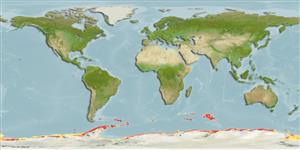Common names from other countries
>
Perciformes/Notothenioidei (Icefishes) >
Nototheniidae (Cod icefishes) > Nototheniinae
Etymology: Lepidonotothen: Greek, lepis = scale + Greek, noton = back + Greek, adverbial particle, then, that denotes distance or remova (Ref. 45335); squamifrons: squamifrons from Latin squama scale, plus frons, frontis forehead for its full upper head cover of small scales (Ref. 11892).
More on author: Günther.
Environment: milieu / climate zone / depth range / distribution range
Écologie
marin benthopélagique; profondeur 10 - 900 m (Ref. 11892), usually 195 - 312 m (Ref. 11892). Temperate; 45°S - 79°S, 180°W - 180°E (Ref. 5179)
Southern Ocean: South Georgia Island and Bouvet Island. Also known from sub-Antarctic islands and Antarctic Indian and Pacific Oceans.
Length at first maturity / Taille / Poids / Âge
Maturity: Lm 27.3, range 19 - 36 cm
Max length : 55.0 cm TL mâle / non sexé; (Ref. 5179); common length : 35.0 cm TL mâle / non sexé; (Ref. 2121); âge max. reporté: 19 années (Ref. 5789)
Épines dorsales (Total): 4 - 5; Rayons mous dorsaux (Total): 36-37; Rayons mous anaux: 29 - 33. Body with 8 or 9 long dusky crossbars, cheek with two oblique dark stripes. First dorsal fin blackish (Ref. 11892).
Feeds chiefly on macrozooplankton (mainly crustaceans, cnidarians and salps) and midwater fishes.
Dewitt, H.H., P.C. Heemstra and O. Gon, 1990. Nototheniidae. p. 279-331. In O. Gon and P.C. Heemstra (eds.) Fishes of the Southern Ocean. J.L.B. Smith Institute of Ichthyology, Grahamstown, South Africa. (Ref. 5179)
Statut dans la liste rouge de l'IUCN (Ref. 130435)
CITES (Ref. 128078)
Not Evaluated
Menace pour l'homme
Harmless
Utilisations par l'homme
Pêcheries: intérêt commercial mineur
Outils
Articles particuliers
Télécharger en XML
Sources Internet
Estimates based on models
Preferred temperature (Ref.
115969): 1.3 - 2.8, mean 1.7 (based on 21 cells).
Phylogenetic diversity index (Ref.
82804): PD
50 = 1.0000 [Uniqueness, from 0.5 = low to 2.0 = high].
Bayesian length-weight: a=0.00468 (0.00393 - 0.00556), b=3.24 (3.19 - 3.29), in cm Total Length, based on LWR estimates for this species (Ref.
93245).
Niveau trophique (Ref.
69278): 3.5 ±0.52 se; based on food items.
Résilience (Ref.
120179): Faible, temps minimum de doublement de population : 4,5 à 14 années (K=0.08-0.12; tm=7-9; tmax=19; Fec = >10,000).
Fishing Vulnerability (Ref.
59153): High to very high vulnerability (67 of 100).
Climate Vulnerability (Ref.
125649): High vulnerability (55 of 100).
